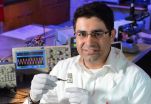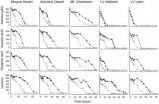(Press-News.org) Suppose you're trying to navigate an unfamiliar section of a big city, and you're using a particular cluster of skyscrapers as a reference point. Traffic and one-way streets force you to take some odd turns, and for a while you lose sight of your landmarks. When they reappear, in order to use them for navigation, you have to be able to identify them as the same buildings you were tracking before — as well as your orientation relative to them.
That type of re-identification is second nature for humans, but it's difficult for computers. At the IEEE Conference on Computer Vision and Pattern Recognition in June, MIT researchers will present a new algorithm that could make it much easier, by identifying the major orientations in 3-D scenes. The same algorithm could also simplify the problem of scene understanding, one of the central challenges in computer vision research.
The algorithm is primarily intended to aid robots navigating unfamiliar buildings, not motorists navigating unfamiliar cities, but the principle is the same. It works by identifying the dominant orientations in a given scene, which it represents as sets of axes — called "Manhattan frames" — embedded in a sphere. As a robot moved, it would, in effect, observe the sphere rotating in the opposite direction, and could gauge its orientation relative to the axes. Whenever it wanted to reorient itself, it would know which of its landmarks' faces should be toward it, making them much easier to identify.
As it turns out, the same algorithm also drastically simplifies the problem of plane segmentation, or deciding which elements of a visual scene lie in which planes, at what depth. Plane segmentation allows a computer to build boxy 3-D models of the objects in the scene — which it could, in turn, match to stored 3-D models of known objects.
Julian Straub, a graduate student in electrical engineering and computer science at MIT, is lead author on the paper. He's joined by his advisors, John Fisher, a senior research scientist in MIT's Computer Science and Artificial Intelligence Laboratory, and John Leonard, a professor of mechanical and ocean engineering, as well as Oren Freifeld and Guy Rosman, both postdocs in Fisher's Sensing, Learning, and Inference Group.
The researchers' new algorithm works on 3-D data of the type captured by the Microsoft Kinect or laser rangefinders. First, using established procedures, the algorithm estimates the orientations of a large number of individual points in the scene. Those orientations are then represented as points on the surface of a sphere, with each point defining a unique angle relative to the sphere's center.
Since the initial orientation estimate is rough, the points on the sphere form loose clusters that can be difficult to distinguish. Using statistical information about the uncertainty of the initial orientation estimates, the algorithm then tries to fit Manhattan frames to the points on the sphere.
The basic idea is similar to that of regression analysis — finding lines that best approximate scatters of points. But it's complicated by the geometry of the sphere. "Most of classical statistics is based on linearity and Euclidean distances, so you can take two points, you can sum them, divide by two, and this will give you the average," Freifeld says. "But once you are working in spaces that are nonlinear, when you do this averaging, you can fall outside the space."
Consider, for instance, the example of measuring geographical distances. "Say that you're in Tokyo and I'm in New York," Freifeld says. "We don't want our average to be in the middle of the Earth; we want it to be on the surface." One of the keys to the new algorithm is the fact it incorporates these geometries into the statistical reasoning about the scene.
In principle, it would be possible to approximate the point data very accurately by using hundreds of different Manhattan frames, but that would yield a model that's much too complex to be useful. So another aspect of the algorithm is a cost function that weighs accuracy of approximation against number of frames. The algorithm starts with a fixed number of frames — somewhere between three and 10, depending on the expected complexity of the scene — and then tries to pare that number down without compromising the overall cost function.
The resulting set of Manhattan frames may not represent subtle distinctions between objects that are slightly misaligned with each other, but those distinctions aren't terribly useful to a navigation system. "Think about how you navigate a room," Fisher says. "You're not building a precise model of your environment. You're sort of capturing loose statistics that allow you to complete your task in a way that you don't stumble over a chair or something like that."
Once a set of Manhattan frames has been determined, the problem of plane segmentation becomes much easier. Objects that don't take up much of the visual field — because they're small, distant, or occluded — make trouble for existing plane segmentation algorithms, because they yield so little depth information that their orientations can't be reliably inferred. But if the problem is one of selecting among just a handful of possible orientations, rather than a potential infinitude, it becomes much more tractable.
INFORMATION:
Written by Larry Hardesty, MIT News Office
New algorithm aids in both robot navigation and scene understanding
Algorithm for determining orientation of objects could aid robots in navigation, scene understanding
2014-04-04
ELSE PRESS RELEASES FROM THIS DATE:
Scientists unmask the climate uncertainty monster
2014-04-04
Scientific uncertainty has been described as a 'monster' that prevents understanding and delays mitigative action in response to climate change. New research by Professor Stephan Lewandowsky of the University of Bristol, and international colleagues, shows that uncertainty should make us more rather than less concerned about climate change.
In two companion papers, published today in Climatic Change, the researchers investigated the mathematics of uncertainty in the climate system and showed that increased scientific uncertainty necessitates even greater action to mitigate ...
Key genetic mutations could be new hope for adrenocortical tumor patients
2014-04-04
April 3, 2014, Shenzhen, China - Chinese researchers from Rui-Jin Hospital, Shanghai Jiao-Tong University School of Medicine, BGI, and other institutions have discovered that the activating hotspot L205R mutation in PRKACA gene was closely associated with adrenocortical tumors (ACTs), and the relationship of recurrently mutated DOT1L and CLASP2 with ACTs' other subtypes. The latest study published online in Science opens a new insight into diagnosis and treatment of Adrenal Cushing's syndrome.
Adrenal Cushing's syndrome results from autonomous production of cortisol ...
An ultrathin collagen matrix biomaterial tool for 3-D microtissue engineering
2014-04-04
A novel ultrathin collagen matrix assembly allows for the unprecedented maintenance of liver cell morphology and function in a microscale "organ-on-a-chip" device that is one example of 3D microtissue engineering.
A team of researchers from the Center for Engineering in Medicine at the Massachusetts General Hospital have demonstrated a new nanoscale matrix biomaterial assembly that can maintain liver cell morphology and function in microfluidic devices for longer times than has been previously been reported in microfluidic devices. This technology allows researchers to ...
Hummingbird evolution soared after they invaded South America 22 million years ago
2014-04-04
A newly constructed family tree of the hummingbirds, published today in the journal Current Biology, tells a story of a unique group of birds that originated in Europe, passed through Asia and North America, and ultimately found its Garden of Eden in South America 22 million years ago.
These early hummingbirds spread rapidly across the South American continent, evolved iridescent colors – various groups are known today as brilliants, topazes, emeralds and gems – diversified into more than 140 new species in the rising Andes, jumped water gaps to invade North America and ...
Iowa State scientist developing materials, electronics that dissolve when triggered
2014-04-04
AMES, Iowa – A medical device, once its job is done, could harmlessly melt away inside a person's body. Or, a military device could collect and send its data and then dissolve away, leaving no trace of an intelligence mission. Or, an environmental sensor could collect climate information, then wash away in the rain.
It's a new way of looking at electronics: "You don't expect your cell phone to dissolve someday, right?" said Reza Montazami, an Iowa State University assistant professor of mechanical engineering. "The resistors, capacitors and electronics, you don't expect ...
Watching for a black hole to gobble up a gas cloud
2014-04-04
Right now a doomed gas cloud is edging ever closer to the supermassive black hole at the center of our Milky Way galaxy. These black holes feed on gas and dust all the time, but astronomers rarely get to see mealtime in action.
Northwestern University's Daryl Haggard has been closely watching the little cloud, called G2, and the black hole, called Sgr A*, as part of a study that should eventually help solve one of the outstanding questions surrounding black holes: How exactly do they achieve such supermassive proportions?
She will discuss her latest data at a press ...
Bacteria get new badge as planet's detoxifier
2014-04-04
Las Vegas - A study published recently in PLOS ONE authored by Dr. Henry Sun and his postdoctoral student Dr. Gaosen Zhang of Nevada based research institute DRI provides new evidence that Earth bacteria can do something that is quite unusual. Despite the fact that these bacteria are made of left-handed (L) amino acids, they are able to grow on right-handed (D) amino acids. This DRI study, funded by the NASA Astrobiology Institute and the NASA Exobiology Program, takes a closer look at what these implications mean for studying organisms on Earth and beyond.
"This finding ...
Knowledge, use of IUDs increases when women are offered counseling and 'same-day' service
2014-04-04
PITTSBURGH, April 3, 2014 – Health care clinics should routinely offer same-day placement of intrauterine devices (IUDs) to women seeking emergency contraception, according to researchers at the University of Pittsburgh School of Medicine. The study findings, published online in the journal Contraception, demonstrate that providing patient education along with same-day placement service increases both knowledge and use of IUDs three months and a year after women seek emergency contraception.
"Women seeking emergency contraception, who are at very high risk of undesired ...
Researchers empower parents to inspire first-generation college-goers
2014-04-04
(PHILADEPHIA) – Parents who have not attended college are at a disadvantage when it comes to talking about higher education with their kids – yet these are the students who most need a parent's guidance.
A new approach developed and tested by researchers at University of the Pacific's Gladys L. Benerd School of Education may help solve the problem. It was presented today at the annual meeting of the American Educational Research Association. [April 4, 8:15 a.m. EDT, Philadelphia Convention Center Terrace Level, Terrace IV]
"There is a common perception that low-income ...
The Trayvon Martin case: Lessons for education researchers
2014-04-04
CHESTNUT HILL, MA (April 4, 2014) – The 2012 fatal shooting of black teenager Trayvon Martin by his Florida neighbor George Zimmerman sparked a fierce debate about racism and gun violence. Now, researchers are exploring what the controversial case says as well about sexism and violence against women.
Boston College Lynch School of Education Professor Ana M. Martinez Aleman spoke today at the American Educational Research Association annual conference in Philadelphia about the highly politicized debate surrounding the Martin case and the implications for researchers who ...
LAST 30 PRESS RELEASES:
Tracing the quick synthesis of an industrially important catalyst
New software sheds light on cancer’s hidden genetic networks
UT Health San Antonio awarded $3 million in CPRIT grants to bolster cancer research and prevention efforts in South Texas
Third symposium spotlights global challenge of new contaminants in China’s fight against pollution
From straw to soil harmony: International team reveals how biochar supercharges carbon-smart farming
Myeloma: How AI is redrawing the map of cancer care
Manhattan E. Charurat, Ph.D., MHS invested as the Homer and Martha Gudelsky Distinguished Professor in Medicine at the University of Maryland School of Medicine
Insilico Medicine’s Pharma.AI Q4 Winter Launch Recap: Revolutionizing drug discovery with cutting-edge AI innovations, accelerating the path to pharmaceutical superintelligence
Nanoplastics have diet-dependent impacts on digestive system health
Brain neuron death occurs throughout life and increases with age, a natural human protein drug may halt neuron death in Alzheimer’s disease
SPIE and CLP announce the recipients of the 2025 Advanced Photonics Young Innovator Award
Lessons from the Caldor Fire’s Christmas Valley ‘Miracle’
Ant societies rose by trading individual protection for collective power
Research reveals how ancient viral DNA shapes early embryonic development
A molecular gatekeeper that controls protein synthesis
New ‘cloaking device’ concept to shield sensitive tech from magnetic fields
Researchers show impact of mountain building and climate change on alpine biodiversity
Study models the transition from Neanderthals to modern humans in Europe
University of Phoenix College of Doctoral Studies releases white paper on AI-driven skilling to reduce burnout and restore worker autonomy
AIs fail at the game of visual “telephone”
The levers for a sustainable food system
Potential changes in US homelessness by ending federal support for housing first programs
Vulnerability of large language models to prompt injection when providing medical advice
Researchers develop new system for high-energy-density, long-life, multi-electron transfer bromine-based flow batteries
Ending federal support for housing first programs could increase U.S. homelessness by 5% in one year, new JAMA study finds
New research uncovers molecular ‘safety switch’ shielding cancers from immune attack
Bacteria resisting viral infection can still sink carbon to ocean floor
Younger biological age may increase depression risk in older women during COVID-19
Bharat Innovates 2026 National Basecamp Showcases India’s Most Promising Deep-Tech Ventures
Here’s what determines whether your income level rises or falls
[Press-News.org] New algorithm aids in both robot navigation and scene understandingAlgorithm for determining orientation of objects could aid robots in navigation, scene understanding




